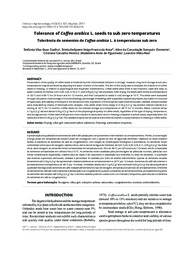Tolerance of Coffea arabica L. seeds to sub zero temperatures.
Tolerance of Coffea arabica L. seeds to sub zero temperatures.
Autoria: COELHO, S. V. B.; ROSA, S. D. V. F. da; CLEMENTE, A. da C. S.; PEREIRA, C. C.; FIGUEIREDO, M. A. de; REIS, L. V.
Resumo: Preservation of the quality of coffee seeds is hindered by their intermediate behavior in storage. However, long-term storage at sub zero temperatures may be achieved by adjusting the water content of the seeds. The aim of this study was to evaluate the tolerance of coffee seeds to freezing, in relation to physiological and enzymatic modifications. Coffee seeds were dried in two manners, rapid and slow, to water contents of interest, 0.67, 0.43, 0.25, 0.18, 0.11, and 0.05 g H2O g-¹ dw (dry basis). After drying, the seeds were stored at a temperature of -20 ºC and of 86 ºC for 24 hours and for 12 months, and then compared to seeds in cold storage at 10 ºC. The seeds were evaluated through calculation of percentage of normal seedlings, percentage of seedlings with expanded cotyledonary leaves, dry matter of roots and of hypocotyls, and viability of embryos in the tetrazolium test. Expression of the enzymes superoxide dismutase, catalase, and peroxidase were evaluated by means of electrophoretic analysis. Only seeds dried more slowly to 0.18 g H2O g-1 dw present relative tolerance to storing at -20 °C for 12 months. Coffee seeds do not tolerate storage at a temperature of -86 ºC for 12 months. Water contents below 0.11g H2O g-¹ dw and above 0.43 g H2O g-¹ dw hurt the physiological quality of coffee seeds, regardless of the type of drying, temperature, and storage period. Coffee seed embryos are more tolerant to desiccation and to freezing compared to whole seeds, especially when the seeds are dried to 0.05 g H2O g-¹ dw. The catalase enzyme can be used as a biochemical marker to study tolerance to freezing in coffee seeds.
Ano de publicação: 2017
Tipo de publicação: Artigo de periódico
Unidade: Embrapa Café
Observações
1 - Por padrão são exibidas publicações dos últimos 20 anos. Para encontrar publicações mais antigas, configure o filtro ano de publicação, colocando o ano a partir do qual você deseja encontrar publicações. O filtro está na coluna da esquerda na busca acima.
2 - Para ler algumas publicações da Embrapa (apenas as que estão em formato ePub), é necessário ter, no celular ou computador, um desses softwares gratuitos. Sistemas Android: Google Play Livros; IOS: iBooks; Windows e Linux: software Calibre.
Acesse outras publicações
Acesse a Base de Dados da Pesquisa Agropecuária (BDPA) para consultar o acervo completo das bibliotecas da Embrapa.

